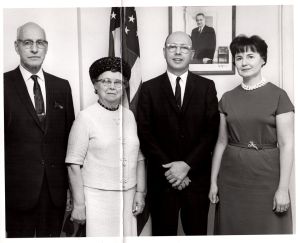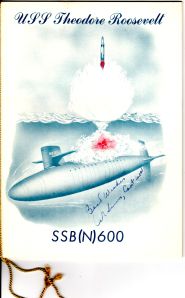As promised, we’re talking here on the blog today about ISU alumnus Dwight Ink. This is not his first time in the spotlight, even in Iowa State-created publications. In 2010, the Iowa State Daily wrote a three–part series about Ink’s roots in Iowa, his relationship with Iowa State, and his long government career. The ISU Alumni Association’s magazine VISIONS, as part of its two-year tour of Iowa, met up with Ink in 2013 at his Virginia home and wrote a two–piece series about their conversations. Since so much has recently been written about Dwight Ink’s life and career, this blog will focus on aspects of Ink’s more than 40-year career that might escape public notice in 2014.

One of my favorite parts of the collection is a bit esoteric – records relating to nuclear-powered ships and submarines that were commissioned in from 1958-1965, a period that saw the build-up of the “Nuclear Navy.” My parents were both officers in the U.S. Coast Guard so I’ve attended a number of events like these, but I did not spend time examining the invitations or programs. After seeing this collection, though, I wish I had paid more attention. As a staff member at the U.S. Atomic Energy Commission (AEC), Ink received a number of items from ceremonies launching new vessels. These act as colorful advertisements for the new members of the Navy’s nuclear fleet, as you can see in the photograph below. While naval-centric items make up a small portion of materials from Ink’s twenty years at the AEC, they are a colorful and informative memento of the military’s relationship with alternative power sources.

Ink’s papers also document more calamitous moments in American history. I mentioned the Good Friday earthquake in Tuesday’s preview post, but it bears more in-depth examination. On March 27, 1964, Good Friday in the Christian liturgical calendar, a 9.2 magnitude earthquake struck the Alaskan coast between the city of Anchorage and the town of Valdez. This earthquake, which remains the second largest in recorded history, was so powerful that it set off a tsunami that damaged Japan’s Pacific coastline; Ink kept tabs on damage to the town of Niigata and made a trip there, which is documented in the collection. In April 1964, President Lyndon Johnson selected Ink as the Executive Director of the Federal Reconstruction and Development Planning Commission, and he spent six months coordinating emergency relief and rebuilding efforts in the towns that populate Alaska’s southern coastline. This experience led Ink to write about emergency relief in the wake of 2005’s Hurricane Katrina, the perceived mismanagement by the Federal Emergency Management Agency, and lessons from Alaska’s 1964 reconstruction that could be applied to modern relief practices. Documentation of the earthquake’s aftermath, economic and engineering rebuilding efforts, and overall coordination of relief efforts are all included in the Dwight Ink Papers and provide insight into just how profound the damage and resulting rebuilding efforts were.
Ink’s career hopped from nuclear power to emergency management to… public art pieces. For three months, March to June 1985, Ink was the Acting Administrator of the U.S. General Services Administration (GSA) while the next Administrator was being confirmed by Congress. It is merely a quirk of timing that Ink came to play a role in a controversy surrounding Tilted Arc, a sculpture that was installed in a courtyard in front of the Jacob K. Javits Federal Office Building in New York City. The sculpture, by artist Richard Serra, was commissioned by the GSA in 1979, assembled in front of the Javits building in 1981, and contested in a three-day hearing in 1985. After years of court battles, Tilted Arc was removed and put in government storage in 1989. As acting Administrator, Ink had the final word in removing the work, and so was named in Serra’s lawsuit to keep the artwork in place. Tilted Arc‘s removal was hotly debated in the pages of The New York Times as well as People magazine.
The Dwight Ink Papers contain something for nearly everyone since they document 40 years working in approximately eleven public administration-related roles within the federal government and the education sector. Ink, who will celebrate his 92nd birthday this September, is currently working on a memoir that I, for one, would love to read. In the meantime, check out the finding aid for RS 21/7/241, the Dwight Ink Papers, and come visit Special Collections to learn more.

One Reply to “”